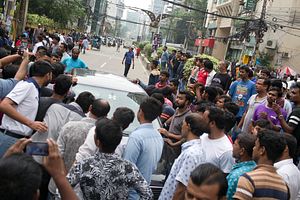Thousands of students gathered in Uttara Model Town, a northern area of Bangladesh’s capital Dhaka on July 31 to protest reckless driving and a perceptibly unresponsive government in the wake of a bus accident that killed two students. Two students were killed on Airport Road when a bus ran into a group of students on July 29.
On the day of the crash, Shipping Minister Shajahan Khan was asked by reporters about the incident but he reportedly laughed off the questions, as the Dhaka Times reported, “by saying that a road crash killed 33 people in India’s Maharashtra, but it was not given as much importance as the Airport Road accident.” Khan is also the executive president of the Bangladesh Sarak Paribahan Sramik Federation (Bangladesh Road Transport Workers Federation).
Students from across the capital took to the streets the following day, blocking traffic and demanding justice. Roads, flooded with students, became impassable and several buses were reportedly vandalized. Even rail lines were blocked, throwing train operations into disarray. That evening, when the students all went home, perhaps the government thought that would be the end of the “childish” protest; they were wrong.
The students returned to the streets the next day, bringing friends and organizing to allow ambulance and rickshaw traffic through the streets but halting buses, the target of their ire.
The July 31 protests prompted the Prime Minister’s Office to order a crackdown on rogue drivers. Khan apologized for his comments, but the students continue to demand his resignation and accuse him of a conflict of interest between his ministerial post and his role heading the transport workers federation.
The students returned to the streets on August 1, in increasing numbers. Students began stopping buses, police cars, and even the Minister of Commerce’s car, asking to see driving licences and requesting that drivers follow and enforce traffic rules. Several videos were posted online of police and bus drivers failing to show legal driving licences.
Local media reported that parents and guardians were joining their children and students in the streets in solidarity and support.
Police tried to use force to dispel the protests but that had little impact as the days progressed. Eventually, the Dhaka Metropolitan Police (DMP) commissioner, Asaduzzaman Mia, reportedly ordered police to not use force against the protesting students. But as the protests continued into a fifth day, police reportedly used tear gas and reported continued to surface of students being treated roughly by police.
The government claimed that during the first three days of protests the students vandalized 309 vehicles and torched eight others. On Wednesday, Home Affairs Minister Asaduzzaman Khan called a press conference urging students to return to their classrooms and promising that their demands would be met.
But the protests continued into a fifth day on August 2, with students chanting “we want justice” in the streets.
According to local media, the students have issued a list of demands, including capital punishment for reckless drivers, an apology from the shipping minister, footbridges at student crossings, and speed-bumps in accident-prone areas.
Khan, the shipping minister, apologized for “unintentionally smiling while speaking about the accident without knowing about it.”
How did the deaths of two students spark such serious protests? Put simply: Bad governance is at the heart of the issue.
At least 4,284 people, including 516 women and 539 children, were killed and 9,112 others injured in 3,472 road accidents across Bangladesh in 2017 according to an observation report by the National Committee to Protect Shipping, Roads, and Railways (NCPSRR), a nongovernment organization. The NCPSRR mentioned nine core reasons behind the high number of accidents and casualties: reckless driving, use of rickshaws and motorbikes, the carrying of passengers and goods in locally made mechanized vehicles, violation of overloading and overtaking laws, drivers not following traffic rules and regulations properly, tired drivers, risky curves and dilapidated roads, nonenforcement of vehicle-related laws and the employment of unskilled drivers.
Mir Rezaul Alam, a DMP additional commissioner for traffic, told the media, “In Dhaka, inefficient and unskilled drivers are running the mass transport system, causing so many accidents. Many of the drivers do not have valid licenses. Police also fail to enforce traffic laws strictly because of lack of manpower in [the] traffic division, recklessness of the drivers, and scattered movement of the pedestrians.”
While the Prime Minister’s Office ordered a crackdown on rogue drivers — to include targeting of underage and drivers without licenses — on July 31, one must ask: Why have such actions not been taken in the past?
Shakil Bin Mushtaq is a Bangladesh-born journalist and author.

































